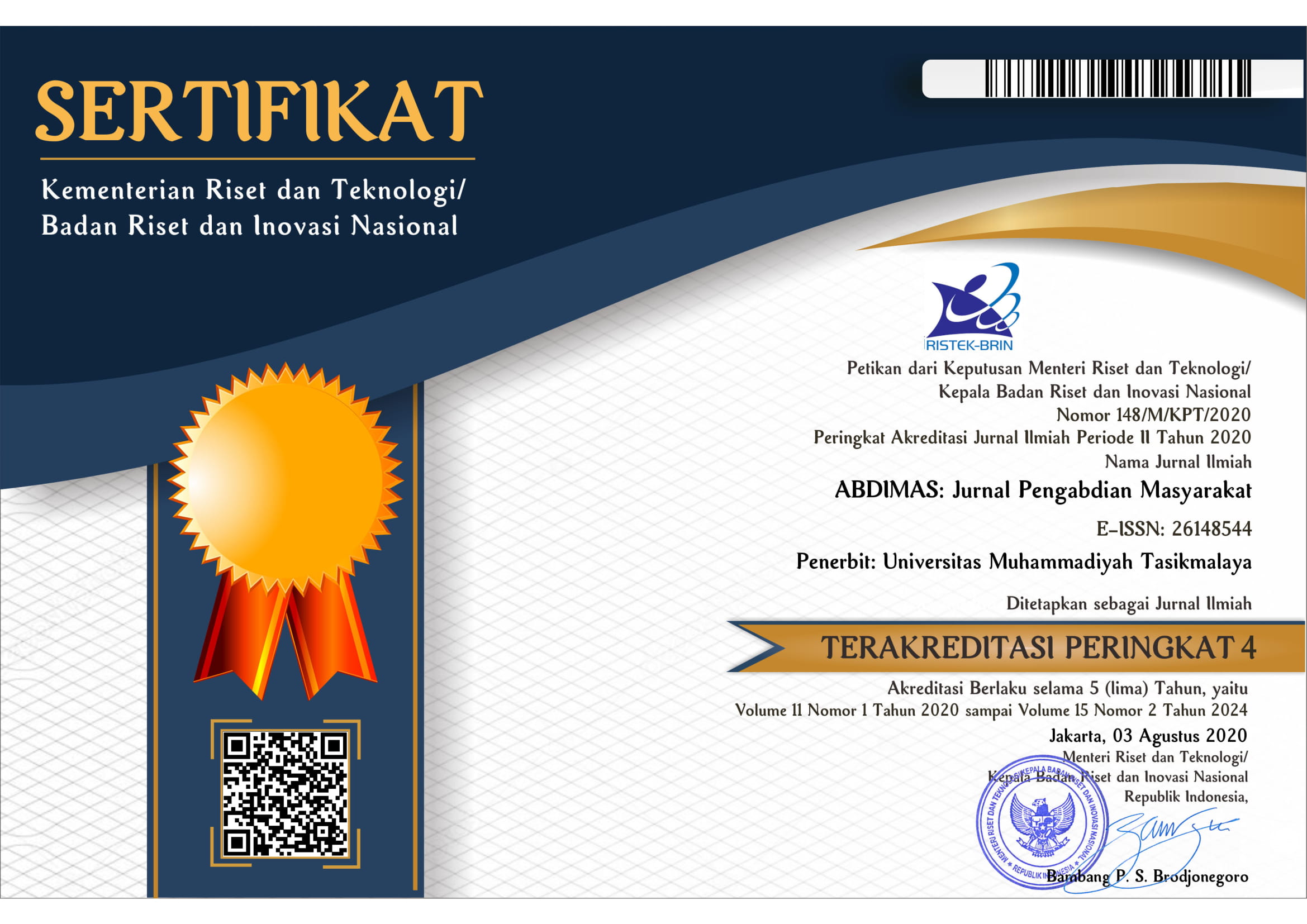Optimization of Mosques, Madrasahs and Islamic Boarding Schools in Eradicating Illiteracy with the Reflect Method in Pamayangsari Hamlet, Cikawungading Village, Tasikmalaya Regency
DOI:
https://doi.org/10.35568/abdimas.v7i2.4734Keywords:
Empowerment, Awarness, LiteracyAbstract
This article aims to describe the condition of illiterate children in Pamayangsari Hamlet, and the application of the reflect method in alleviating illiteracy. This article uses descriptive analytic method with data collection through interviews and observations to the community. At the observation stage, the problem of illiteracy was found in children aged 6-12 years. During implementation, empowerment is carried out in mosques and madrasas. The next stage is awareness, where the community is educated about the importance of literacy. Activities are carried out in an interesting way so that children are more likely to like them, such as competitions and other educational activities. The last program is action, focusing on direct teaching to overcome illiteracy. Evaluation is done through observation, community enthusiasm and assessment of children's literacy skills. In conclusion, the reflect method yielded significant results in alleviating illiteracy.
Downloads
References
Bahri, E. S. (2013). Community Empowerment: Concepts and Applications. FAM Publishing. https://books.google.co.id/books?id=993kDwAAQBAJ
Creswell, J. W., & Creswell, J. D. (2022). Research Design: Qualitative, Quantitative, and Mixed Methods Approaches (6th edition). Sage Productions inc.
Febriana, R. (2021). Learning Evaluation. Bumi Aksara. https://books.google.co.id/books?id=moM_EAAAQBAJ
Furoidah, R. R. F., & Rohinah. (2019). Implementation of Syllabic Method in Early Childhood Reading Habituation in Group B1 of IT Salsabila Al-Muthi'in Banguntapan Kindergarten. Proceedings of The 4th Annual Conference on Islamic Early Childhood Education, 4, 515-526.
Harahap, F. I. N., Ariana, Hasibuan, A. R., & Anggraini, N. (2021). ILLITERACY ERADICATION STRATEGY USING REFLECT METHOD IN UNITY VILLAGE, ASAHAN DISTRICT, NORTH SUMATRA. Akrab, 12(2), 52-60.
Hasanah, Y. M., Ibnatur, H. N. R., Masitoh, L. F., & Aedi, W. G. (2020). ALLEVIATING ILLITERACY OF STREET CHILDREN THROUGH THE READING PROGRAM AT BAMBOO RAINBOW LAPAK SARMILI BINTARO. JAMAIKA: Journal of Abdi Masyarakat, 1(3), 133-139. http://openjournal.unpam.ac.id/index.php/JAMAIKA/article/view/6891
Indriani. (2021). Illiteracy rate in Indonesia decreases to 1.71 percent. September 6, 2021. https://sumut.antaranews.com/berita/418678/angka-buta-aksara-di-indonesia-menurun-jadi-171-persen
Khasanah, U. (2020). Introduction to Microteaching. Deep Publish. https://books.google.co.id/books?id=RQzyDwAAQBAJ
Machmudi, M. I. (2021). There are still 2.9 million illiterate people in Indonesia. September 4, 2021. https://mediaindonesia.com/humaniora/430374/masih-ada-29-juta-orang-buta-aksara-di-indonesia
Mariyono, M. (2016). Illiteracy Eradication Strategy through the Use of Family-Based Metastasis Technique. Pancaran Pendidikan, 5(1), 55-66.
Muryadi, A. D. (2017). Program Evaluation Model in Evaluation Research. Scientific Journal of PE, 3(1), 1-16.
Puspitasari, Y., Bulqiah, F. B., Herdiansyah, D. P., Siti Nur Komariyatul, H., Ita, U., Rian Agus, P., Niken Pundri, S., Yudis, S., Malikal, B., Khozaimah, K., & Raudhatun, N. (2023). Empowering the Illiterate Elderly Community to Improve Reading and Writing Literacy in Siliwung Village. J-ABDI: Journal of Community Service, 3(4), 717-722. https://doi.org/10.53625/jabdi.v3i4.6465
Rasyid, H. (2015). Building a Generation Through Education as a Future Investment. Journal of Child Education, 4(1), 565-581. https://doi.org/10.21831/jpa.v4i1.12345
Statistics, B. P. (2023). Illiteracy Rate by Province and Age Group - Statistical Tables - Central Bureau of Statistics of Indonesia. December 14, 2023.
Sumardi, K. (2008). Basic Literacy Learning Model Using a Combination of Reflect, Lea, and Pre Methods. JIV - Scientific Journal of Vision, 3(2), 107-119. https://doi.org/10.21009/jiv.0302.1












